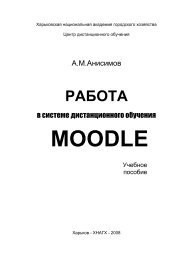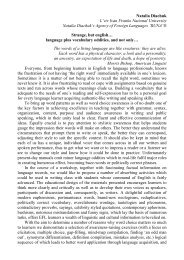міністерство освіти і науки, молоді та спорту україни харківська ...
міністерство освіти і науки, молоді та спорту україни харківська ...
міністерство освіти і науки, молоді та спорту україни харківська ...
You also want an ePaper? Increase the reach of your titles
YUMPU automatically turns print PDFs into web optimized ePapers that Google loves.
But there are a lot of other differences as well. Gothic cathedrals have many<br />
more windows, and much bigger windows, and so they are not dark like Romanesque<br />
churches. This is because the architects have learned some new ways of making roofs<br />
and of supporting walls, especially the groin vault and the flying buttress.<br />
The Medieval Gothic Arch was a major feature of the architecture of the<br />
Middle Ages. The Gothic architects and builders discovered the amazing strength and<br />
stability of using pointed arches. The walls of Gothic buildings could be thinner<br />
because the weight of the roof was supported by the arches rather than the walls. The<br />
use of the Gothic arch gave the builders tremendous flexibility. The arch could not<br />
only support greater weights but could also span greater distances, allowing vaults to<br />
be taller and wider. Thinner walls had wider window openings which encouraged the<br />
use of stained glass and the magnificent Gothic Rose Windows.<br />
Gothic churches are also usually bigger than Romanesque churches. By 1200<br />
AD, people had more money available, and they could afford to spend more on<br />
building great churches. And, where many Romanesque churches had wooden roofs<br />
(which were always catching fire), Gothic churches had safer stone roofs.<br />
Gargoyles are a fascinating element of Gothic Architecture. These frightening<br />
sculptures are most often associated with Medieval Churches and Cathedrals but they<br />
were also used to great effect in English Gothic castles. Gargoyles are frightening and<br />
intimidating sculptures - perfect for the likes of great Lords and Kings who built<br />
elaborate fortresses and castles in order to crush and intimidate the indigenous<br />
population.<br />
The origins of the word 'gargoyle' are derived from the old French word<br />
'gargouille' meaning throat. Gargoyles came into gothic architecture in the early 13th<br />
century and are defined as "a waterspout, projecting from an upper part of a building<br />
to throw water clear of walls or foundations."<br />
1. Gothic architecture is a style of architecture which flourished during:<br />
(A) late medieval period.<br />
(B) early medieval period.<br />
36

















